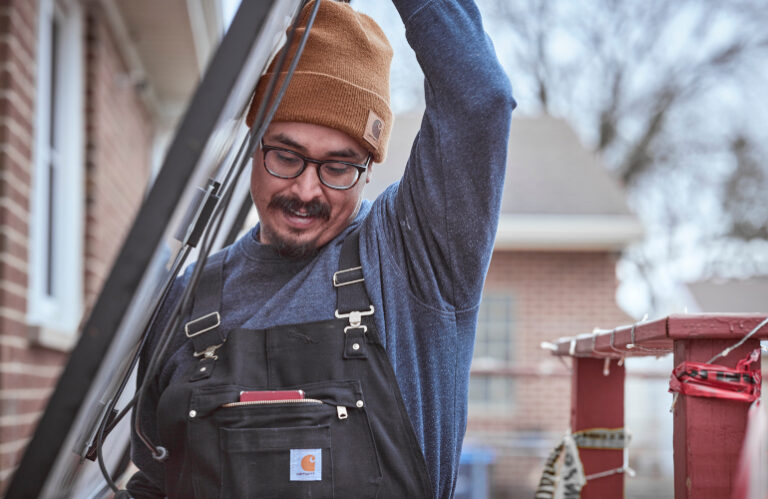Solar Power World has dedicated its March 2024 coverage to installation tips for solar contractors big and small. You can read the rest of our Q&As in the magazine and online here.
For insight into the “safety and wearables” segment, SPW talked with Kendra Lewinski, senior marketing manager at Carhartt Company Gear, to learn more about how clothing makes the solar installer.
What apparel does Carhartt offer that is relevant to solar contractors?

Carhartt x SunRun
Carhartt Company Gear is the uniform solutions arm of Carhartt, offering Carhartt’s durable, quality product that is curated and purpose-built to support crews of 10 to 10,000. With a selection of UV-rated T-shirts, long-sleeves, sweatshirts and button downs, as well as a variety of work jackets, pants, shorts and gloves, our product offerings stack up against any weather condition solar crews and contractors may face – from severe sun exposure and heat to the bitter winter cold, and everything in between.
Carhartt recently partnered with Sunrun to outfit and help protect their 5,000 technicians and installation crews. Solar companies can see how Carhartt gear is supporting solar work crews like Sunrun online.
How much of a difference does using UV-rated clothing make in regions with high sun exposure?
At Carhartt, we exist to serve and protect all hardworking people. For solar contractors exposed to the elements and sun during hot, humid weather, there is no escaping the challenging working conditions. Providing the right equipment and tools, like UV-rated clothing, is imperative to supporting and keeping crews safe.

Carhartt x SunRun
For solar contractors, the right equipment includes the right clothing to get the job done. Carhartt offers functional sun protection in our Force series of product which has 30-50 UPF. Force Sun Defender garments, our newest products available now online and coming soon to Company Gear, offer a minimum of 50 UPF. The Carhartt Force products that include UPF offer superior sun protection and have added functional features that stretch, wick moisture and are lightweight, which ensure solar contractors and crews are safer and more comfortable. This gear also comes in women’s compatible styles to ensure Carhartt is outfitting the entire crew.
Carhartt released a heat safety whitepaper that communicates smart steps to help crews avoid heat-related injuries. Tips include:
- Act before it gets hot: OSHA estimates that 50-70% of outdoor worker heat-related fatalities occur in the first few days of working in hot weather. Make sure your crew has the right workwear and safety procedures (i.e. water, frequent breaks to cool down, keeping an eye on workers) in place when you know high heat is coming.
- Educate your crew: Make sure your crew understands that heat stress can be dangerous and educate them on ways to beat the heat before these weather conditions arrive.
- Provide the right equipment and tools: Companies should look for ways to improve jobsite resiliency by building in plans for dealing with extreme temperatures. During the high-heat months, provide workers PPE with advanced UV-protective fabric technologies. Other remedies like portable fans, water misters and simple barrier protection, like tarps or screens, can help reduce the danger.
How can solar contractors stay warm while working at heights?
For solar contractors, working at a higher elevation or in winter weather can present three different job site challenges: air temperature, wind velocity and humidity/participation levels. The good news is that crews can be prepared by having the right gear and apparel. Staying true to our mission to protect crews under any condition, Carhartt offers an assortment of cold weather gear at a range of different warmth levels to help protect crews in various elements.
What is the ideal outfit for a solar contractor to complement the equipment and safety gear they’re using on the job?
The ideal outfit for a solar contractor is one that fits and performs based on the current conditions and their specific job function. Solar contractors who are in the elements day in and day out need products that will stand up to the conditions and keep them protected. Workers who are exposed to potential industrial flash fire through electrical work will need PPE/flame-resistant gear. From the individual worker perspective, a recent third-party study showcased that the most important thing about clothing is gear that keeps them safe and is durable.


